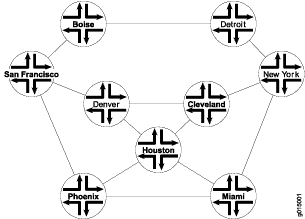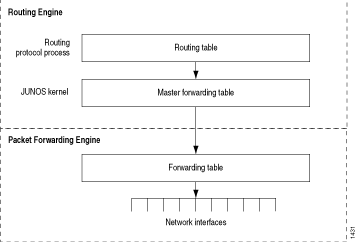Routing Databases Overview
Routing is the transmission of packets from a source to a destination address. A routing protocol determines the path by which the packets are forwarded, shares information with immediate neighbor devices and other devices in the network, and adjusts to changing network conditions.
To use the routing capabilities of a Juniper Networks device, you must understand the fundamentals of IP routing and the routing protocols that are primarily responsible for the transmission of unicast traffic. To understand this topic, you need a basic understanding of IP addressing and TCP/IP.
The Junos® operating system (Junos OS) maintains two databases for routing information:
-
Routing table—Contains all the routing information learned by all routing protocols.
-
Forwarding table—Contains the routes actually used to forward packets through the router.
In addition, the interior gateway protocols (IGPs), IS-IS, and OSPF maintain link-state databases.
This section includes the following topics:
Routing Protocol Databases
Each IGP routing protocol maintains a database of the routing information it has learned from other routers running the same protocol and uses this information as defined and required by the protocol. Routing information that is shared within an AS is transmitted by an interior gateway protocol (IGP).
Of the different IGPs, the most common are RIP, OSPF, and IS-IS. IS-IS and OSPF use the routing information they received to maintain link-state databases, which they use to determine which adjacent neighbors are operational and to construct network topology maps. IGPs are designed to be fast acting and light duty. They typically incorporate only a moderate security system, because trusted internal peers do not require the stringent security measures that untrusted peers require. As a result, you can usually begin routing within an AS by enabling the IGP on all internal interfaces and performing minimal additional configuration. You do not need to establish individual adjacencies.
IS-IS and OSPF use the Dijkstra algorithm, and RIP and RIPng use the Bellman-Ford algorithm to determine the best route or routes (if there are multiple equal-cost routes) to reach each destination and install these routes into the Junos OS routing table.
Routing information that is shared with a peer AS is transmitted by an exterior gateway protocol (EGP). The primary EGP in use in almost all networks is the Border Gateway Protocol (BGP). BGP is designed to be very secure. Individual connections must be explicitly configured on each side of the link. As a result, although large numbers of connections are difficult to configure and maintain, each connection is secure.
When you configure a protocol on an interface, you must also configure a protocol family on that interface.
Junos OS Routing Tables
The Junos OS routing table is used by the routing protocol process to maintain its database of routing information. In this table, the routing protocol process stores statically configured routes, directly connected interfaces (also called direct routes or interface routes), and all routing information learned from all routing protocols. The routing protocol process uses this collected routing information to select the active route to each destination, which is the route that actually is used to forward packets to that destination. To route traffic from a source host to a destination host, the devices through which the traffic will pass must learn the path that the packet is to take. Once learned, the information is stored in routing tables. The routing table maintains a list of all the possible paths from point A to point B.
By default, the Junos OS maintains three routing tables: one for unicast routes, another for multicast routes, and a third for MPLS. You can configure additional routing tables to support situations where you need to separate a particular group of routes or where you need greater flexibility in manipulating routing information. In general, most operations can be performed without resorting to the complexity of additional routing tables. However, creating additional routing tables has several specific uses, including importing interface routes into more than one routing table, applying different routing policies when exporting the same route to different peers, and providing greater flexibility with incongruent multicast topologies.
Each routing table is identified by a name, which consists of the protocol family followed by a period and a small, nonnegative integer. The protocol family can be inet (Internet), iso (ISO), or mpls (MPLS). The following names are reserved for the default routing tables maintained by the Junos OS:
-
inet.0—Default IP version 4 (IPv4) unicast routing table
-
inet6.0—Default IP version 6 (IPv6) unicast routing table
-
instance-name.inet.0—Unicast routing table for a particular routing instance
-
inet.1—Multicast forwarding cache
-
inet.2—Unicast routes used for multicast reverse path forwarding (RPF) lookup
-
inet.3—MPLS routing table for path information
-
mpls.0—MPLS routing table for label-switched path (LSP) next hops
Note:For clarity, this topic contains general discussions of routing tables as if there were only one table. However, when it is necessary to distinguish among the routing tables, their names are explicitly used.
Networks and Subnetworks
Large groups of machines that are interconnected and can communicate with one another form networks. Typically, networks identify large systems of computers and devices that are owned or operated by a single entity. Traffic is routed between or through the networks as data is passed from host to host.
Figure 1 shows a simple network of routers.

This simple network provides multiple ways to get from host San Francisco to host Miami. The packet can follow the path through Denver and Cleveland. Alternatively, the packet can be routed through Phoenix and directly to Miami. The routing table includes all the possible paths and combinations—an exhaustive list of all the ways to get from the source to the destination.
The routing table must include every possible path from a source to a destination. Routing tables for the network in Figure 1 must include entries for San Francisco-Denver, San Francisco-Cleveland, San Francisco-Miami, Denver-Cleveland, and so on. As the number of sources and destinations increases, the routing table quickly becomes large. The unwieldy size of routing tables is the primary reason for the division of networks into subnetworks.
As networks grow large, the ability to maintain the network and effectively route traffic between hosts within the network becomes increasingly difficult. To accommodate growth, networks are divided into subnetworks. Fundamentally, subnetworks behave exactly like networks, except that they are identified by a more specific network address and subnet mask (destination prefix). Subnetworks have routing gateways and share routing information in exactly the same way as large networks.
Forwarding Tables
Routing is the transmission of data packets from a source to a destination address. It involves delivering a message across a network or networks. This process has two primary components: the exchange of routing information to forward packets accurately from source to destination and the packet-forwarding procedure.
For packets to be correctly forwarded to the appropriate host address, the host must have a unique numeric identifier or IP address. The unique IP address of the destination host forms entries in the routing table. These entries are primarily responsible for determining the path that a packet traverses when transmitted from source to destination.
The Junos OS installs all active routes from the routing table into the forwarding table. The active routes are used to forward packets to their destinations.
The Junos OS kernel maintains a master copy of the forwarding table. It copies the forwarding table to the Packet Forwarding Engine, which is the part of the router responsible for forwarding packets.
If the routing table is a list of all the possible paths a packet can take, the forwarding table is a list of only the best routes to a particular destination. The best path is determined according to the particular routing protocol being used, but generally the number of hops between the source and destination determines the best possible route.
In the network shown in Figure 1, because the path with the fewest number of hops from San Francisco to Miami is through Phoenix, the forwarding table distills all the possible San Francisco-Miami routes into the single route through Phoenix. All traffic with a destination address of Miami is sent directly to the next hop, Phoenix.
After it receives a packet, the Phoenix router performs another route lookup, using the same destination address. The Phoenix router then routes the packet appropriately. Although it considers the entire path, the router at any individual hop along the way is responsible only for transmitting the packet to the next hop in the path. If the Phoenix router is managing its traffic in a particular way, it might send the packet through Houston on its route to Miami. This scenario is likely if specific customer traffic is treated as priority traffic and routed through a faster or more direct route, while all other traffic is treated as nonpriority traffic.
How the Routing and Forwarding Tables Are Synchronized
The Junos OS routing protocol process is responsible for synchronizing the routing information between the routing and forwarding tables. To do this, the routing protocol process calculates the active routes from all the routes in the routing table and installs them into the forwarding table. The routing protocol process then copies the forwarding table to the router’s Packet Forwarding Engine, the part of the router that forwards packets. Figure 2 illustrates how the routing tables are synchronized.

NetFlow V9 Support
NetFlow Services Export Version 9 (NetFlow V9) provides an extensible and flexible method for using templates to observe packets on a router. Each template indicates the format in which the router exports data.
This feature supports Netflow V5 or V8 for flow-based devices.
For more information, see Monitoring, Sampling, and Collection Services Interfaces User Guide.
